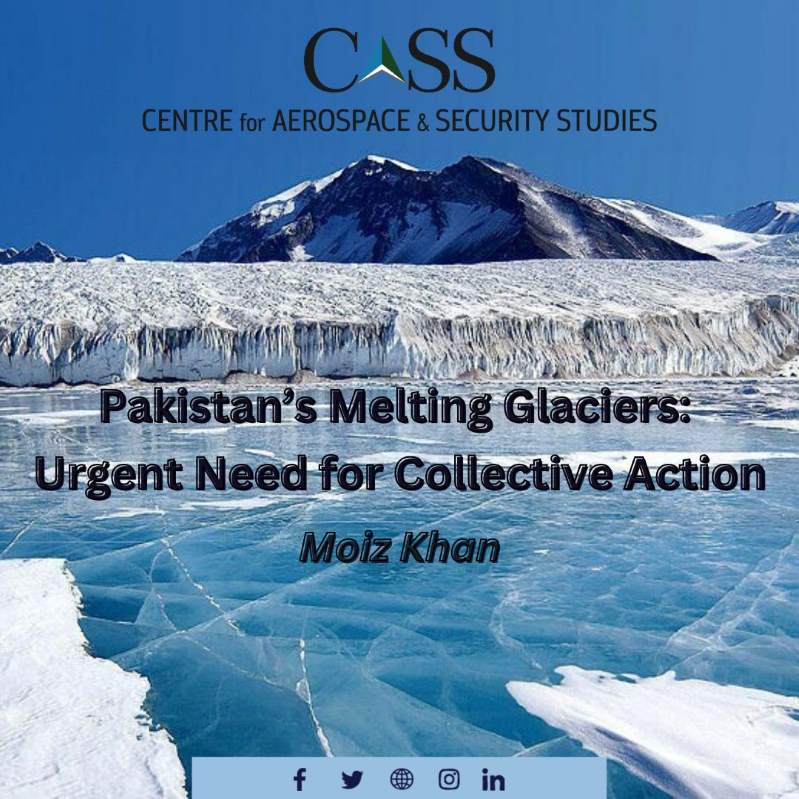Climate change is turning into an existential threat with repercussions reverberating across the whole world. Like many other developing countries, Pakistan confronts profound challenges from increasing global warming – ranking 8th in the world’s most vulnerable countries to long-term climate risk, despite being responsible for less than 1 percent carbon emissions. While its geographical position renders it susceptible for persistent high temperatures, floods and droughts, Pakistan’s vast glaciers, often dubbed the ‘third pole’ of the world, exacerbate its vulnerability. Increasing global warming, caused by developed nations’ carbon footprints, directly contributes to the accelerated melting of these glaciers. This increased melting can cause catastrophic ramifications such as floods, landslides, and socioeconomic crisis.
Glaciers act as reservoirs of water in the form of ice and gradually release it as melted water, which contributes to rivers and lakes. Analysing glaciers can provide valuable insights into climate change, as they reflect variations in global temperatures. Pakistan has a significant number of glaciers, approximately 7,253, situated in the Hindu Kush, Karakoram, and Himalayan Mountain ranges. These glaciers cover a substantial portion of the country’s territory, playing a vital role as the primary source of freshwater for the Indus River Basin. Besides providing fresh drinking water, they also support agriculture, irrigation, and the generation of hydropower.
However, a large number of these glaciers have been melting, owing to the rising temperature and changing precipitation patterns. The glacial meltdown leads to the formation of glacial lakes. In the Gilgit-Baltistan and Khyber Pakhtunkhwa regions, approximately 3,044 glacial lakes have been formed, with nearly 33 of them posing a threat of hazardous Glacial Lake Outburst Flooding (GLOF), putting 7.1 million people at risk. GLOF occurs when a large amount of water is unexpectedly released from glacial lakes, causing release of excess water that flood the downstream rivers and lakes. These GLOFs can cause devastating flash floods downstream, destroying infrastructure, crops, livestock, and human lives.
In 2022, Pakistan witnessed an alarming increase in Glacial Lake Outburst Floods (GLOFs), with a total of at least 16 incidents recorded. This was a significant rise compared to the previous average of five to six GLOFs per year. The increased frequency of GLOFs was compounded by extreme precipitation and heavy summer monsoon rains, leading to devastating floods across the country. The floods in 2022 had a catastrophic impact on Pakistan, affecting nearly 33 million people. Moreover, the destruction caused was extensive, with approximately 2.2 million houses either damaged or destroyed, and at least 1,700 people lost their lives. According to a LUMS report, the estimated loss and damage was around USD 15.2 billion and USD 14.9 billion, respectively.
Glacial meltdown also contributes to water scarcity and droughts in the long term as glaciers shrink and disappear. The Indus River Basin has already shrunk into a canal in Sindh Province, causing farmers to migrate owing to water shortage. Pakistan ranks 14 out of 17 ‘extremely high-water risk’ countries of the world, with 80 percent population facing severe water scarcity. It is feared that glaciers in the Hindu Kush Himalayan region could lose up to two-thirds of its ice mass by 2100 if global efforts fail to tackle climate change. The adverse impact of the climate change can also be seen on the ecosystem and habitats, such as the snow leopard, in the region.
Pakistan has been taking several steps to address the melting glaciers’ issue and mitigate their effects. The United Nations Development Programme and the Ministry of Climate Change have collaborated on GLOF risk reduction projects. The ‘Scaling-Up of Glacial Lake Outburst Flood Risk Reduction in Northern Pakistan Project’ (GLOF-II), launched in 2017, builds on the earlier GLOF-I project (2011-16), which helped in creating institutions, early warning systems, evacuation plans and raising public awareness. GLOF-II (2017-24) is ‘aimed building 250 engineering structures including dams, ponds, spill ways, tree plantation and drainage to reduce risk. At the same time, the development of disaster management policies and the introduction of weather monitoring stations, flood gauges, hydrological modelling and early warning systems will increase the ability to respond rapidly to flood scenarios.’ The adoption of drought-resilient crops and the development of water storage infrastructure would also reduce the risks of floods and water scarcity.
The implications of melting glaciers in Pakistan extend far beyond its borders, with regional impacts that cannot be ignored. Addressing this pressing issue requires a unified effort from all countries in the region. It is crucial for nations, including developed ones, to come together and collaborate in order to make substantial progress.
To effectively tackle the challenges posed by melting glaciers and climate change, developed countries must take the lead in reducing their carbon emissions. This includes implementing measures to cut down on emissions and actively promoting research and innovation to find innovative solutions for mitigating the effects of melting glaciers. Moreover, developed nations should extend their support to developing countries by assisting them in enhancing their resilience to climate change.
Moiz Khan is a Research Assistant at the Centre for Aerospace & Security Studies (CASS), Islamabad, Pakistan. He can be reached at cass.thinkers@casstt.com
Design Credit: Mysha Dua Salman




